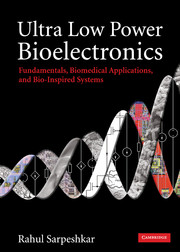Book contents
- Frontmatter
- Contents
- Acknowledgements
- Section I Foundations
- 1 The big picture
- 2 Feedback systems: fundamentals, benefits, and root-locus analysis
- 3 MOS device physics: general treatment
- 4 MOS device physics: practical treatment
- 5 MOS device physics: small-signal operation
- 6 Deep submicron effects in MOS transistors
- 7 Noise in devices
- 8 Noise in electrical and non-electrical circuits
- 9 Feedback systems
- 10 Return-ratio analysis
- Section II Low-power analog and biomedical circuits
- Section III Low-power RF and energy-harvesting circuits for biomedical systems
- Section IV Biomedical electronic systems
- Section V Principles for ultra-low-power analog and digital design
- Section VI Bio-inspired systems
- Section VII Energy sources
- Bibliography
- Index
- Epilogue
- References
5 - MOS device physics: small-signal operation
from Section I - Foundations
Published online by Cambridge University Press: 02 December 2010
- Frontmatter
- Contents
- Acknowledgements
- Section I Foundations
- 1 The big picture
- 2 Feedback systems: fundamentals, benefits, and root-locus analysis
- 3 MOS device physics: general treatment
- 4 MOS device physics: practical treatment
- 5 MOS device physics: small-signal operation
- 6 Deep submicron effects in MOS transistors
- 7 Noise in devices
- 8 Noise in electrical and non-electrical circuits
- 9 Feedback systems
- 10 Return-ratio analysis
- Section II Low-power analog and biomedical circuits
- Section III Low-power RF and energy-harvesting circuits for biomedical systems
- Section IV Biomedical electronic systems
- Section V Principles for ultra-low-power analog and digital design
- Section VI Bio-inspired systems
- Section VII Energy sources
- Bibliography
- Index
- Epilogue
- References
Summary
All difficult things have their origin in that which is easy, and great things in that which is small.
Lao TzuIn many systems, certain important transistors in an architecture that determine most of its performance are operated such that the current through them has a large-signal dc bias component around which there are small-signal ac deviations. The voltages of these transistors correspondingly also have a dc large-signal operating point and small-signal ac deviations. If the ac deviations are sufficiently small, the transistor may be characterized as a linear system in its ac small-signal variables with the parameters of the linear system being determined by the dc large-signal variables. In this chapter, we will focus on the small-signal properties of the transistor.
Given that the transistor is a highly nonlinear device, it may be surprising that we are interested in its linear small-signal behavior. However, the transistor's linear small-signal behavior is most important in determining its behavior in analog feedback loops that are intentionally designed to have a linear input-output relationship in spite of nonlinear devices in the architecture. For example, most operational amplifier (opamp) circuits are architected such that negative feedback inherent in the topology ensures that the input terminal voltages of the opamp, v+ and v−, will be very near each other and, therefore, that the small-signal properties of the transistors in the opamp determine its stability and convergence in most situations.
Information
- Type
- Chapter
- Information
- Ultra Low Power BioelectronicsFundamentals, Biomedical Applications, and Bio-Inspired Systems, pp. 103 - 128Publisher: Cambridge University PressPrint publication year: 2010
